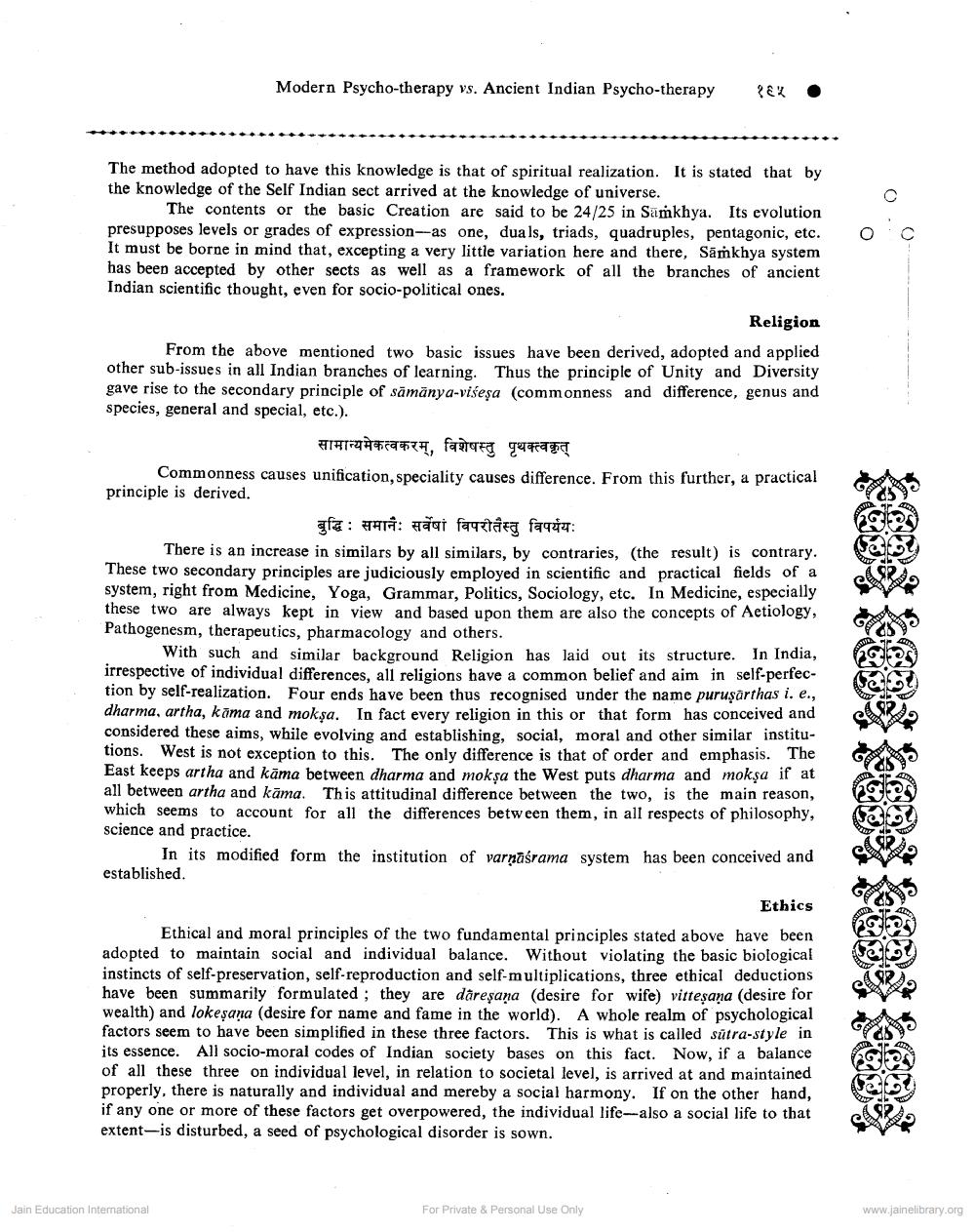________________
Modern Psycho-therapy vs. Ancient Indian Psycho-therapy
The method adopted to have this knowledge is that of spiritual realization. It is stated that by the knowledge of the Self Indian sect arrived at the knowledge of universe.
The contents or the basic Creation are said to be 24/25 in Samkhya. Its evolution presupposes levels or grades of expression-as one, duals, triads, quadruples, pentagonic, etc. It must be borne in mind that, excepting a very little variation here and there, Samkhya system has been accepted by other sects as well as a framework of all the branches of ancient Indian scientific thought, even for socio-political ones.
१६५
Religion
From the above mentioned two basic issues have been derived, adopted and applied other sub-issues in all Indian branches of learning. Thus the principle of Unity and Diversity gave rise to the secondary principle of samanya-viseşa (commonness and difference, genus and species, general and special, etc.).
सामान्यमेकत्वकरम्, विशेषस्तु पृथक्त्वकृत्
Commonness causes unification, speciality causes difference. From this further, a practical principle is derived.
बुद्धि समानः सर्वेषा विपरीतस्तु विपर्ययः
There is an increase in similars by all similars, by contraries, (the result) is contrary. These two secondary principles are judiciously employed in scientific and practical fields of a system, right from Medicine, Yoga, Grammar, Politics, Sociology, etc. In Medicine, especially these two are always kept in view and based upon them are also the concepts of Aetiology, Pathogenesm, therapeutics, pharmacology and others.
With such and similar background Religion has laid out its structure. In India, irrespective of individual differences, all religions have a common belief and aim in self-perfection by self-realization. Four ends have been thus recognised under the name puruşarthas i. e., dharma, artha, kama and mokşa. In fact every religion in this or that form has conceived and considered these aims, while evolving and establishing, social, moral and other similar institutions. West is not exception to this. The only difference is that of order and emphasis. The East keeps artha and kama between dharma and mokşa the West puts dharma and moksa if at all between artha and kāma. This attitudinal difference between the two, is the main reason, which seems to account for all the differences between them, in all respects of philosophy, science and practice.
In its modified form the institution of varnasrama system has been conceived and established.
Jain Education International
Ethics
Ethical and moral principles of the two fundamental principles stated above have been adopted to maintain social and individual balance. Without violating the basic biological instincts of self-preservation, self-reproduction and self-multiplications, three ethical deductions have been summarily formulated; they are dareşana (desire for wife) vitteşana (desire for wealth) and lokeşana (desire for name and fame in the world). A whole realm of psychological factors seem to have been simplified in these three factors. This is what is called sutra-style in its essence. All socio-moral codes of Indian society bases on this fact. Now, if a balance of all these three on individual level, in relation to societal level, is arrived at and maintained properly, there is naturally and individual and mereby a social harmony. If on the other hand, if any one or more of these factors get overpowered, the individual life-also a social life to that extent is disturbed, a seed of psychological disorder is sown.
For Private & Personal Use Only
www.jainelibrary.org




